The National League arguably entered 1880 in the best shape it had been in yet. Only one franchise had left the circuit;
The reserve clause was the brainchild of Bostons’s Arthur Soden, one of the three “triumvirs” who owned and operated the club. Soden had a reputation as a skinflint, and he was still smarting over the defections of Jim O’Rourke and George Wright to
As usual, there were a fair number of on-field rule alterations. A foul ball fielded on the first bounce was once again an out after a year of using the modern rule. The number of balls needed for a walk was reduced to eight, and a third strike had to be caught on the fly for an automatic out. Additionally, the bottom of the ninth was no longer required to be played out if the home team had secured victory.
The pennant race was not much of one. The perpetually under achieving Chicago White Stockings blew the NL away, winning by fifteen games with a 67-17 record (good for an unsurpassed winning percentage of .798). Any doubt was removed in June, when
The dull season did include several impressive individual feats. On June 10, Charley Jones of
The off-season would yield some drama as
STANDINGS
In 1880, the league hit .255/.271/.329, for a .094 SEC, 4.69 runs and 23.96 outs per game. The 4.69 runs was easily the lowest yet in the NL, as was the error rate (as seen in the .901 fielding average). Compared to 1876, R/G had dropped by 1.2 and the fielding average had improved by 35 points.
CHICAGO
The White Stockings exploded on the league with improvement both at the plate and in the field, but it was the defense that made the big step forward. The regular lineup was largely intact (rookie Tom Burns took over shortstop, while King Kelly was pilfered from
Offensively, Ed Williamson took a major step back in value while Silver Flint went from above average to below replacement level. This was offset, though, by a full season from a healthy Anson; replacing John Peters’ aging bat with Burns; and most of all, star-caliber seasons from Abner Dalrymple and second-year center fielder George Gore.
The Grays did not have the services of Bobby Mathews this season (I’m not sure why, and some very perfunctory searching didn’t turn anything up), but they replaced him ably with
John Peters brought his declining offense with him from the
The catching duties were turned over to Emil Gross, who had a promising rookie campaign in 1879 (a 167 ARG in 136 PA). He caught every inning of every game, and demonstrated that his offensive showing had been no fluke.
CLEVELAND
The Blues improved by twenty games largely due to the emergence of Jim McCormick as a very good (and iron; he pitched 63 innings more than anyone else in the league) pitcher, and rookie second baseman Fred Dunlap. Frank Hankinson and Orator Shaffer came over from the White Stockings while Pete Hotaling came from
Rookie Ned Hanlon took over in the outfield after Al Hall, formerly with
McCormick’s fine season was highlighted by his performance against the juggernaut White Stockings. No team (other than
The Trojans overhauled half of their lineup, finding productive rookies in Roger Connor and Pete Gillespie, promoting John Cassidy and manager Bob Ferguson to regular roles, and bringing in Bill Holbert from Syracuse and Ed Cogswell from Boston (Cogswell took first base away from Dan Brouthers, who played in just three games). Their most fruitful move was replacing George Bradley as primary pitcher with a pair of outstanding rookies: 23 year old Tim Keefe and 20 year old Mickey Welch. Along with
The NL relented this season and allowed
Boston and Providence had been so sure that
Also of note is Keefe’s performance; I have him down for a 46 ARA, which is obviously great, but wouldn’t set any records. Baseball-Reference.com and other sources credit him with the best ERA+ in baseball history, 294. First, I’m not crazy about him being eligible as he only tossed 105 innings (the B-R criterion is one IP per team game; he qualifies, but pitching 105 innings in 83 team games while other pitchers in the league are pitching 500+ innings is not quite the same as 180 innings in 162 team games, as far as I’m concerned).
Secondly, Keefe allowed a large number of unearned runs, even for the time and place. He allowed 27 runs, only 10 of which were earned (37%). The team as a whole allowed 51% earned runs, while the league allowed 50% earned runs. It was certainly an impressive rookie season, but it was nowhere near being one of the greatest seasons of all-time.
WORCESTER
The Brown Stockings had to struggle to even gain entry to the National League, which had a rule that a city must have a population of 75,000 or else require unanimous approval from the other clubs.
The team used a variety of innovative techniques for financing, including: selling shares in the club (season tickets included) for $35, selling women-only season tickets, and holding a benefit walk that attracted 3,000 people.
The Brown Stockings lineup was comprised primarily of rookies and former NLers. Rookie pitcher Lee Richmond was a
Rookies Harry Stovey and Arthur Irwin were the team’s top position players, while Art Whitney and George Wood were also rookie contributors. Charlie Bennett, the fine catcher, had last played for
In the campaign against the sinful Reds, one of the leading voices was the Worcester Spy. Unfortunately for the Brown Stockings,
The Reds turned in what was easily the worst season in franchise history. The team had never before finished below a .557 W% or below third place, dating back to 1871. They also won NA/NL pennants in 1872-1875 and 1877-1878.
What was the cause? The team suffered WAR declines at every position except second base and right field (where Jim O’Rourke returned after a year in
However, the biggest problem was the collapse of Tommy Bond. Bond had totaled 12.4 WAR in his first three years in
The decision to suspend and have one of their best players, Charley Jones, blacklisted did not help either. Soden ran the team along with two other men; they were collectively known as the Triumvirs and were considered very cheap. Supposedly they even collected the tickets at the gate themselves on occasion. Jones and Soden did battle when the outfielder asked for payment (reported as $378) while on a road trip. While the payday had technically come, it was customary for players to be paid when the team returned home. Soden decided to leave Jones behind in
As an aside, a lot of these anecdotes may be apocryphal, to some extent or another. I am not a historian, and I have relied solely on secondary sources to gather them. So take them with a grain of salt, and please don’t get the impression that I’m trying to pass this off as a meticulous, 100% accurate history, or that I’m trying to pass myself off as a historian.
Case in point is how I have switched to using “Reds” as a nickname for
As long as somebody, somewhere referred to the team by a given nickname, that’s enough for me. I treat it as if I was writing about contemporary baseball, in which case I might refer to the “Bronx Bombers”, “the Tribe”, “the White Elephants”, “the Buccos”, etc. Using those nicknames in those veins is in no way a claim that they are official, team-approved, used extensively in press coverage, etc. It is in that same spirit that I used nicknames for the nineteenth century clubs.
The Bisons collapsed from third place to seventh place and a sub-.300 W%. It didn’t help that Pud Galvin’s innings declined from 593 to 459, with his effectiveness also taking a serious hit (95 ARA to 113); he also held out in
Chuck Fulmer, my choice for all-star second baseman in 1879, played in just eleven games. The team also lost catcher and manager John Clapp. Rookie catcher Jack Rowe was solid, and rookie shortstop Mike Moynahan was very good in limited time (106 PA), but fellow rookies Dude Esterbrook and Ecky Stearns combined for sub-replacement level performance.
This Reds club was not the same one that competed in the NL in 1879. Instead, an independent team called the Stars was drafted to replace them. Thus, these new Reds did not have many carryovers from the decent 1879 club. The White brothers were the only returnees amongst the regulars, and Deacon missed much of the first half tending to his ailing wife, playing right field when he returned. Will suffered through a terrible season (-3.1 WAR). John Clapp was brought in from
Any disappointment Reilly may have had over a replacement-level rookie season was probably offset by sheer joy of being alive. According to his SABR BioProject entry (written by David Ball, whose “Nineteenth Century Transactions Register” has also been a valuable source), Reilly and the Reds played in
Reilly helped in various rescue efforts on board, then jumped into the water when it seemed the ship would sink and floated for around an hour while holding to piece of wood before being rescued. The Reds and Grays played again the next day, unsure of whether Reilly was dead or alive at first. He returned to the lineup on the 15th.
While errors were still quite common, the Reds’ August 28 game against
The Reds as a major league franchise would not share the same joy of being alive as their first baseman once the season was over. The team insisted on renting its park out to non-league clubs that sold alcohol and played on Sundays. This led to calls for punishment against the sinners, with the aforementioned Worcester Spy a major player. A
On October 6, the NL voted unofficially to ban alcohol sales and Sunday ball on team grounds, 7-1.
(The league leaders and my "all-star" picks will be a seperate post, as Blogger will not allow to write anything past this point without double spaces. Why? I don't have a clue, and I'm not going to learn HTML to divine it. Also notice the single spaces after periods, which were double spaces in my Word document.)

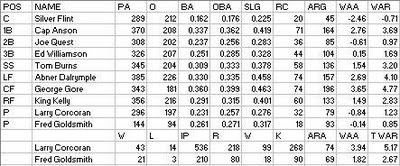
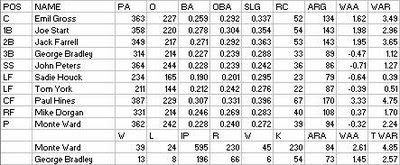
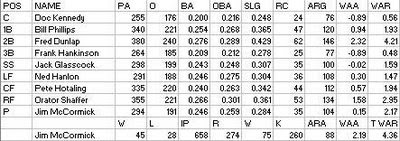

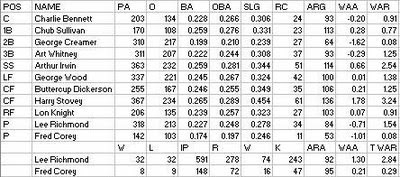
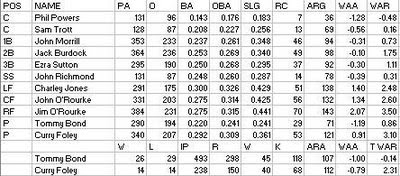

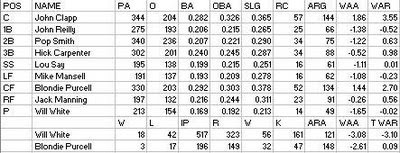
A couple of (belated) notes. The I'm not sure what event happened on September 29, 1879 that you are thinking of, but the demise of the International Association wasn't it. The IA changed its name to the National Association following the 1878 season, as it no longer had any Canadian members. It lasted two more seasons, with a rump version in 1880 initially with three members: the Nationals of Washington, the Baltimores and the Albanys. Baltimore and Albany didn't last the season, but the Rochester club entered midseason. Some sources talk of an Athletics of Philadelphia and a Jersey City club joining, but this is incorrect. There was talk of this, but nothing came of it.
ReplyDeleteRegarding the reserve clause, the idea that the reserved players considered it an honor is propaganda put out by the owners. It is frequently repeated today, but I know of no evidence for its being true.
And yes, using "Reds" rather than "Red Caps" is a vast improvement. Thank you.
Thanks (as always) for the feedback.
ReplyDeleteMy BS meter was set off by the claim that players liked being reserved, but shame on me for running with it anyway.
My source for the 9/29/79 claim was Nemec's Encyclopedia, pg 125 of the first edition:
"The very day the Reserve Clause was born, September 29, 1879, the International Association collapsed."
I'm not sure what Nemec was thinking of, unless he was being poetic and ascribing the collapse of the IA to the reserve clause. I would find a claim of causality suspect. the IA/NA was collapsing quite nicely on its own.
ReplyDelete